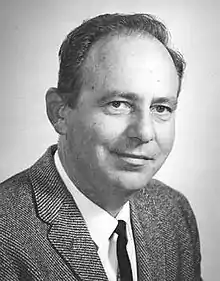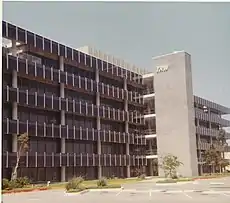James L. Buie
James L. Buie (1920 – September 25, 1988) was an American scientist and inventor working for TRW Inc who developed transistor–transistor logic, a form of integrated circuit technology that became widely used early in the integrated circuit industry.
James L. Buie | |
|---|---|
 Buie, c. 1964 | |
| Born | 1920 |
| Died | (aged 68) |
| Alma mater | University of Southern California |
| Known for |
|
| Awards | The United States Distinguished Flying Cross |
| Scientific career | |
| Fields | Electrical Engineering |
| Institutions |
|


Biography
Early life
James L. Buie was born in 1920 in Hollywood, California. He went to the local public schools and graduated from Hollywood High School. He then attended the Los Angeles City College and received an associate's degree. Buie served in World War II as an naval aviator and became a lieutenant commander.[1][2][3] He was awarded the United States Distinguished Flying Cross for action during May 26–31, 1944.[2][4]
Buie, an electrical engineering graduate of University of Southern California who received a BSEE in 1950, took his first job at Pacific Semiconductors (PSI) in Culver City, California in 1951, where he worked on transistor circuitry as related to diodes and resistors.[1][5][6] He was next employed by Ramo-Woolridge Corporation in 1954; Ramo-Woolridge joined with Thompson Automotive Group in 1958, and eventually in 1965 Thompson-Ramo-Woolridge became known as TRW Inc.[1][2][7][8]
Career
Buie invented transistor-to-transistor logic circuitry ("TTL") in 1961 at TRW which played a major role in the development of the integrated circuit industry.[2][9][10] TTL integrated circuits use transistors for the input gating structure instead of diodes, resistors, and capacitors as was used in the previous technology. His TTL semiconductor technology initially was used in mainframe computers. Buie's integrated circuit chips in the 1970s were the preferred technology for mini-computers, computer peripherals, factory controls, and test instrumentation. The microelectronic processor-based systems he invented were an industrial standard for two decades from the 1980s onwards.[11]
TRW licensed the new technology to other companies to use in data processing and communications electronics. Buie was a senior scientist and one of the organizers for TRW's Microelectronics Center that formed in 1963.[12] The first commercial integrated circuit products using the TTL technology were made by Sylvania in 1963 and known as the Sylvania Universal High-Level Logic family.[13][14] The TTL electronics Buie invented became the electronics industry standard from the mid-1960s,[15] and the dominant architecture for integrated circuit technology in the 1970s and early 1980s. He helped establish TRW's large scale integration LSI Products Division in 1977.[1]
Later life and death
Buie was elected a Fellow of the IEEE[16] in 1973.[17] He officially retired from TRW in 1978 as a full-time worker. He then began part-time work as a consultant for the Large Scale Integration division of the company (TRW/LSI Products). Buie then invented other related integrated circuits and patented those "chips", as they were called then. Buie's integrated circuit chip technology was used in various electronics of space satellites and computers into the 1990s.[11][18] His TTL integrated circuit technology is a fundamental foundation of the electronics industry.[2][7]
Buie developed emphysema caused by smoking in the 1970s and quit at the time of his retirement. His lungs continued to deteriorate at an accelerated rate that was faster that natural. He was on oxygen assistance from 1985 and continued to consult part-time for TRW. In March of 1988 he no longer could physically make the trip to his offices there and then just did some work on his personal computer at home communicating with TRW by phone. Buie continued to fail in health and died in Panorama City on September 25, 1988, aged 68. He is buried at Fort Rosecrans National Cemetery.[19][7][18]
References
Citations
- Lee, J. A. N. (2013). "Computer Pioneers". James L. Buie. IEEE Computer Society. Retrieved November 14, 2015.
While working for TRW, Inc., Los Angeles, in the early 1960s, Buie developed and patented TTL circuitry, which became the dominant IC technology in the 1970s and early 1980s
- Weiss, Eric A., ed. (1989). "James A. Buie". Annals of the History of Computing. 11 (1): 49. doi:10.1109/MAHC.1989.10004. Retrieved December 13, 2022.
- Register of Retired Commission and Warrant Officers
- "Hall of Valor: Distinguished Flying Cross: James L. Buie". Military Times. 2015. Retrieved November 14, 2015.
- "Independent inventions of TTL". The Rise of TTL: How Fairchild Won a Battle But Lost the War. Computer History Museum. 13 July 2015. Retrieved November 14, 2015.
- New in Integrated Circuits: Transistor-Coupled Logic, Hayden Publishing Company, 1961, p. V9_Part4_p2, retrieved November 15, 2015
- "James L. Buie, 68; Scientist, Inventor". Los Angeles Times. Los Angeles, California. September 28, 1988 – via Newspapers.com
 .
. Sep 28, 1988 – James L. Buie, whose many patents included one for electronic logic devices that led to the start of the integrated circuit industry, has died.
- Keller, John (2022). "Former TRW Space Park, now Northrop Grumman, designated as historic site for electronics and aerospace work". Military-Aerospace Electronics. Endeavor Business Media. Retrieved June 26, 2022.
- "1963 – Standard Logic IC Families introduced". The Silicon Engine. Computer History Museum. 2014.
Patented by James Buie of Pacific Semiconductor in 1961, TTL (Transistor Transistor Logic) emerged as the most popular logic configuration of the next two decades.
- "Electronics". Electronics. McGraw-Hill Publishing Company. 53. 1980.
The logic known today as standard transistor-transistor logic, or TTL, evolved from work done at several sources, but can be traced to James L. Buie, an IC designer at Pacific Semiconductors, who had devised in 1961 a better coupling technique that isolated stages with coupling transistors.
- Scaruffi, Piero (2018). "A Brief History of Electrical Technology Part 5: The Integrated Circuit and the Arpanet".
- "Moves". Frequency Technology. Frequency, Inc.: 9 1970.
- "Logic Families (book review)". Better World Books. 2015. Retrieved November 16, 2015.
TTL was invented in 1961 by James L. Buie of TRW, "particularly suited to the newly developing integrated circuit design technology." The first commercial integrated-circuit TTL devices were manufactured by Sylvania in 1963, called the Sylvania Universal High-Level Logic family.
- "The Fascinating Transistor-transistor Logic (TTL) Clock!". ScienceProg. CircuitGeek. 2008. Retrieved November 14, 2015.
- John Keller (December 18, 2011). "Former TRW Space Park, now Northrop Grumman, designated as historic site for electronics and aerospace work". Space Technology. Military & Aerospace Electronics. Retrieved November 15, 2015.
The TTL logic gate, which was the electronics industry standard for two decades, was invented by TRW's James L. Buie in 1961.
- "IEEE Fellow Nominations". IEEE Acoustics, Speech, and Signal Processing Newsletter. IEEE. 51 (1): 28–30. September 1980. doi:10.1109/MSP.1980.237181.
- "James L. Buie, 68; Scientist, Inventor". Los Angeles Times. September 28, 1988.
Buie, who retired in 1983, was a graduate of USC. He was elected a fellow of the Institute of Electrical and Electronics Engineers in 1973.
- "Taxing Smokers/Proposition 99". The Los Angeles Times. Los Angeles, California. October 14, 1988. p. 50 – via Newspapers.com
 .
. - "James L. Buie obituary". Daily News of Los Angeles (CA). September 27, 1988.
Bibliography
- Burghartz, Joachim N. (2013). State-of-the-Art Electron Devices (Ebook). John Wiley & Sons. ISBN 978-1-118-51753-6.